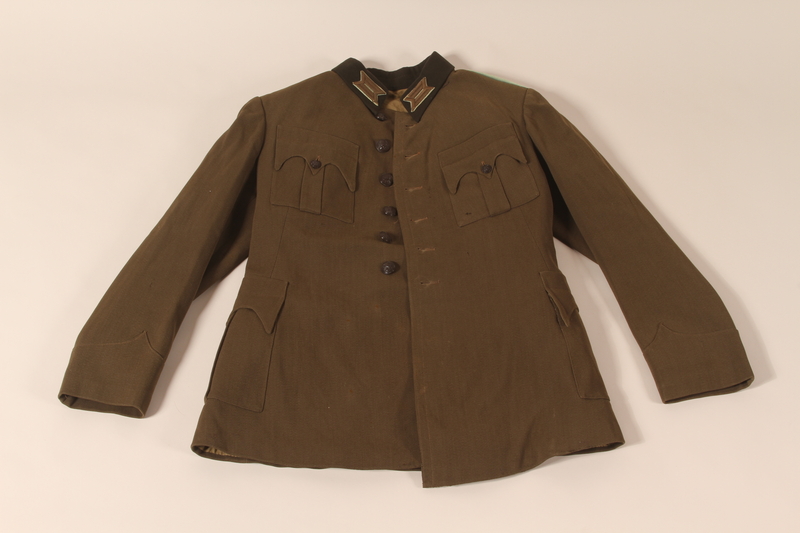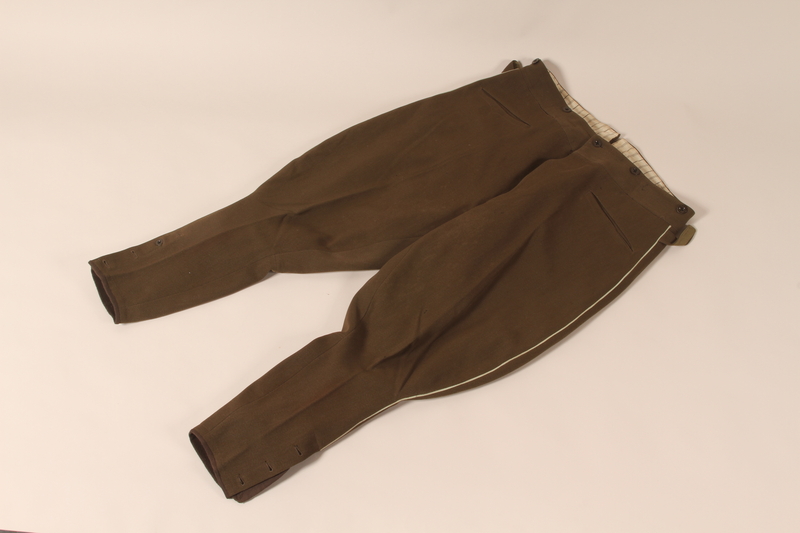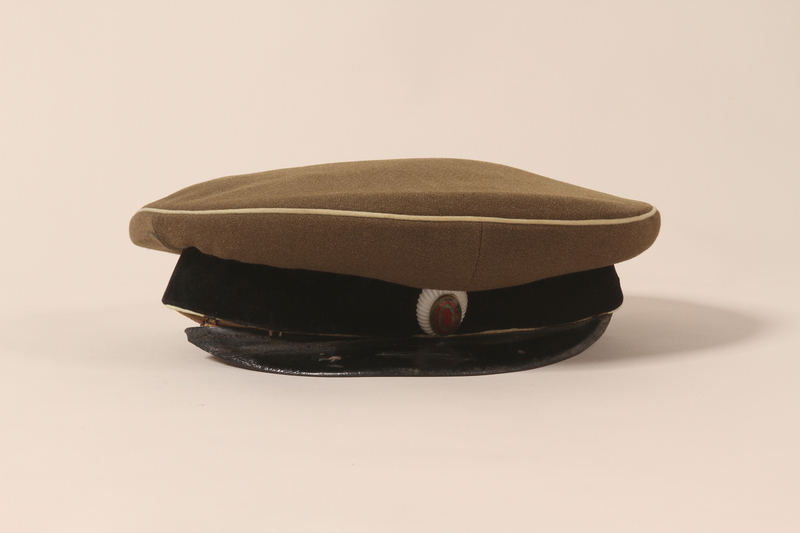Overview
- Brief Narrative
- Uniform hat, jacket, and pants worn by Nissim Farhi when he was drafted by Bulgaria to serve as an officer for a Jewish forced labor unit from 1940-1941. It was the same uniform that he had worn as an army officer during World War I. Nissim, with his wife, Carolina, and their sons David, Albert, and Mike, lived in Sofia, where Nissim was a private banker. After the Jews were expelled from Sofia, the family moved to Pleven and then to Shumen. The family returned to Sofia after Bulgaria was liberated by the Soviet Army on September 9, 1944.
- Date
-
received:
1914-1918
use: 1940-1941
- Geography
-
use:
Sofia (Bulgaria)
- Credit Line
- United States Holocaust Memorial Museum Collection, Gift of Albert Farhi
- Markings
- b. on waistband button : FOR GENTLEMEN***
c. inside band, silver ink : Teopru H. Tlonobro & Topamro (Cyrillic word)
c. label with Cyrillic text and a symbol - Contributor
-
Subject:
Nissim Farhi
- Biography
-
Nissim Farhi was born in Shumen, Bulgaria. He attended a military academy in Sofia, Bulgaria and served as an officer in World War I on the Macedonian front. He married Carolina, also from Shuman, and they settled in Sofia and had 3 sons: David, born in 1924, Albert, born on May 15, 1929, and Moise (Mike). After the First World War ended in 1918, Nissim established a successful business as a private banker in Sofia. In addition, he was a skilled violinist and a founding member of the Sofia Jewish Symphony Orchestra. His sons attended a private Jewish elementary school, and the eldest went on to attend the American College near Sofia.
In July 1940, the Bulgarian Legislature introduced anti-Jewish legislation that prohibited Jews from owning businesses or intermarrying. Jews had to obey strict curfews and wear the Jewish star, and they were forced into ghettos. Although Nissim lost his business, he was able to keep his home, and the Farhi family did not relocate to the ghetto. In 1941, all Bulgarian Jewish men between the ages of 20 and 40 were conscripted for forced labor. Unlike other countries, Jewish officers retained their status and could socialize with non-Jewish officers. Nissim wore his officer's uniform and worked in the canteen, supplying food for the soldiers. Later in 1941, the Nazi party pressured the Bulgarian government to prohibit Jews from serving as officers. By then, Nissim was too old to be conscripted for forced labor and was released from service and allowed to return home. Soon after this, Jewish citizens were required to register their belongings with the government; the Farhi family was able to entrust some of their valuable possessions to non-Jews for safekeeping.
In May 1943, the Bulgarian government ordered the deportation of Jews from the capital, Sofia. They were given three days to prepare. Each person was allowed 25 kilos, about 55 pounds, of luggage for their journey. Carolina was able to entrust some items to several non-Jewish friends. She gave her husband's military uniform to her neighbor. Mrs. Durvov; the family piano was entrusted to a Christian relative of another Jewish neighbor. Albert went to the American College to bring his brother home. He and the other Jewish students were not aware of the deportation order. From Sofia, the family was deported by train to Pleven. They arrived in the middle of the night and were greeted by the president of the Jewish Congregation, Mr. Pinchas, who allowed the deportees to live in his home. While in Pleven, the brothers performed manual labor and David collected money on behalf of local partisan groups. After a few months, the family moved to Shumen to stay with extended family. There, Albert attended a Bulgarian High School, and the family participated in Jewish communal activities. They remained in Shumen until the end of the war. After the Red Army entered Bulgaria on September 9, 1944, Nissim returned to Sofia to examine their apartment, which had been damaged during the aerial bombardments, as well as to search for their belongings. Some items, such as the piano and uniform, were promptly returned. But Nissim managed to recover a list of their items that had been sold at auction. Using this list, Nissim was able to contact the buyers and recover many items. In February 1949, Albert moved to Israel and joined the Hagana. Shortly afterwards, his parents and younger brother joined him there. His older brother David went to Paris after the war to study at the Sorbonne and then later moved to Israel
Physical Details
- Classification
-
Clothing and Dress
- Category
-
Military uniforms
- Object Type
-
Military uniforms (lcsh)
- Physical Description
- a. Long sleeved, green cloth jacket with a stand up collar and 2 hourglass shaped patches. Shoulder epaulets have cream piping with a brown and black center stripe, a square ornament, a plastic # 5, and a plastic button with a rampant lion. There are 2 hook and eye closures on the collar, and a button placket with 6 plastic and metal buttons. Each breast has a pleated flap pocket with a 3-pointed flap with plastic and metal buttons and snaps. There are 2 similar pockets at the waist. The sleeve cuff has a chevron detail. There is a back vent; above the vents are 2 metal hooks with buttons in the form of rampant lions, possibly for a belt.
b. Green cloth jodhpurs with a v-inset in the back waistband and 7 plastic buttons within. The side seam has cream piping and a fabric strap and metal buckle sewn into a back dart seam. On the right backside is a pocket with a fabric loop closure and a button. There is a small seam pocket below the right front waistband and 2 seam pockets on each side of the front hip. The waistband closes with a central button; below is a hook and eye and a 4 button fly. The cuffs are slit with a placket and three buttons, with a brown piped hem. The pants flare through the thighs and taper below the knee to about mid-calf.
c. Green cloth hat with a wide black velvet band with leather lining around the brow. There is cream piping below and above the band and around the flat top. On the front center of the velvet band is a white plastic ornament with a metal medal. The bill is made of black leather and fiberboard. The interior has a green cloth lining with a strap and a circular paper tag. There is an inner circular form around the hat and a padded, boning structure above the brim. - Dimensions
- a: Height: 30.000 inches (76.2 cm) | Width: 22.500 inches (57.15 cm)
b: Height: 39.750 inches (100.965 cm) | Width: 19.000 inches (48.26 cm)
c: Height: 3.620 inches (9.195 cm) | Width: 10.000 inches (25.4 cm) | Depth: 9.500 inches (24.13 cm) - Materials
- a : cloth, plastic, metal, thread
b : cloth, plastic, metal, thread
c : cloth, leather, plastic, adhesive, metal
Rights & Restrictions
- Conditions on Access
- No restrictions on access
- Conditions on Use
- No restrictions on use
Keywords & Subjects
Administrative Notes
- Legal Status
- Permanent Collection
- Provenance
- The uniform was donated to the United States Holocaust Memorial Museum in 2007 by Albert Farhi, the son of Nissim Farhi.
- Record last modified:
- 2022-07-28 17:50:47
- This page:
- https://collections.ushmm.org/search/catalog/irn35856
Download & Licensing
In-Person Research
- By Appointment
- Request 21 Days in Advance of Visit
- Plan a Research Visit
- Request to See This Object






